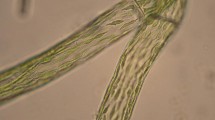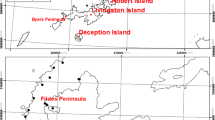Abstract
Bryophytes from submerged habitats are particularly difficult to identify because developmental plasticity obscures their characteristic features. A deep-water moss population of uncertain identity was found isolated at a depth of 31 m within the perennially ice-covered Lake Vanda, Wright Valley, Antarctica. Through phylogenetic analysis of the chloroplast region, ribosomal subunit 4 gene, nuclear ribosomal DNA region, and the internal transcribed spacer region, the Lake Vanda moss was identified as the cosmopolitan species Bryum pseudotriquetrum and resolved to a clade containing exclusively specimens from Antarctica, specifically those from the neighbouring Taylor Valley and Granite Harbour. The close genetic similarity of the Lake Vanda population to other populations of B. pseudotriquetrum in Southern Victoria Land suggests that colonisation was likely to have been from local sources, and colonisation likely occurred at least 80–100 years ago, given the position of mosses in the deeper of two convection cells in the lake. Light and scanning electron microscopy of in vitro cultured specimens revealed adaptations to permanent submersion, including very thin cell walls, which may increase CO2 absorption under water. The production of rhizoidal knots in contaminated, low-nutrient media, but not in axenic cultures, might result from interactions between the moss and organisms in the microbial mat from which it was isolated. The absence of mosses around the lake margin or elsewhere in Wright Valley highlights the importance of freshwater ecosystems as refugia for biodiversity in Antarctica.




Similar content being viewed by others
References
Ares A, Duckett JG, Pressel S (2014) Asexual development and protonemal development in vitro in Fontinalis antipyretica Hedw. J Bryol 36:122–133
Bednarek-Ochyra H, Váňa J, Ochyra R, Lewis Smith RI (2000) The liverwort flora of Antarctica. Polish Academy of Sciences, Krakow
Berg A, Danielsson Å, Svensson BH (2013) Transfer of fixed-N from N2-fixing cyanobacteria associated with the moss Sphagnum riparium results in enhanced growth of the moss. Plant Soil 362:271–278
Castendyk DN, Obryk MK, Leidman SZ, Gooseff M, Hawes I (2016) Lake Vanda: a sentinel for climate change in the McMurdo Sound regions of Antarctica. Glob Planet Change 144:213–227
Convey P, Stevens MI, Hodgson DA, Smellie JL, Hillenbrand C-D, Barnes DKA, Clarke A, Pugh PJA, Linse K, Cary SC (2009) Exploring biological constraints on the glacial history of Antarctica. Quat Sci Rev 28:3035–3048
Cox CJ, Hedderson TAJ (1999) Phylogenetic relationships among the ciliate arthrodontous mosses: evidence from chloroplast and nuclear DNA sequences. Plant Syst Evol 215:119–139
Cox CJ, Hedderson TAJ (2003) Phylogenetic relationships within the moss family Bryaceae based on chloroplast DNA evidence. J Bryol 25:31–40
Darriba D, Taboada GL, Doallo R, Posada D (2012) jModelTest 2: more models, new heuristics and parallel computing. Nat Methods 9:772
de Winton MD, Beever JE (2004) Deep-water bryophyte records from New Zealand lakes. New Zeal J Mar Fresh Res 38:329–340
Drummond AJ, Rambaut A (2007) BEAST: Bayesian evolutionary analysis by sampling trees. BMC Evol Biol 7:214
Drummond AJ, Suchard MA, Xie D, Rambaut A (2012) Bayesian phylogenetics with BEAUti and the BEAST 1.7. Mol Biol Evol 29:1969–1973
Duckett JG (1994) Studies of protonemal morphogenesis in mosses VI. The foliar rhizoids of Calliergon stramineum (Brid.) Kindb. function as organs of attachment. J Bryol 18:239–252
Duckett JG, Ligrone R (1995) Cyathodium Kunze, (Cyathodiaceae, Marchantiales), a tropical liverwort genus and family new to Europe, in Southern Italy. J Bryol 28:88–96
Duckett JG, Matcham HW (1995) Studies of protonemal morphogenesis in mosses VII. The perennial rhizoids and gemmiferous protonema of Dicranella heteromalla (Hedw.) Schimp. J Bryol 18:407–424
Duckett JG, Burch J, Fletcher PW, Matcham HW, Read DJ, Russell AJ, Pressel S (2004) In vitro cultivation of bryophytes: a review of practicalities, problems, progress and promise. J Bryol 26:3–20
Ellis LT et al (2014) Bryological Notes new national and regional bryophyte records 41. Bryol 36:306–324
Ellis-Evans JC, Walton D (1990) The process of colonisation in Antarctic terrestrial and freshwater ecosystems. Polar Biol 3:151–163
Felsenstein J (1993) Phylip (phylogeny inference package), version 3.5c. Distributed by the author. Department of Genome Sciences, University of Washington, Seattle
Gąbka M, Rusińska A, Barylski J (2014) Floristic studies on freshwater algae of Lake Gondwana, Northern Victoria Land (Antarctica). Hydrobiologia 316:81–90
Glime JM, Knoop BC (1986) Spore germination and protonema development of Fontinalis squamosa. J Hattori Bot Lab 61:487–497
Glime JM, Vitt DH (1986) A comparison of bryophyte species diversity and niche structure of montane streams and banks. Can J Bot 65:1824–1837
Goode JA, Duckett JG, Stead AJ (1992) Towards an understanding of developmental interrelationships between chloronema, caulonema, rhizoids and plates in mosses; a comparative study. Cryptogam Bot 3:50–59
Guerra J, Jiménez-Martínez JF, Cano MJ, Jiménez-Fernández JA (2011) A contribution to the phylogenetic study of Mielichhoferiaceae-Mniaceae (Bryophyta) based on molecular sequence data. Nova Hedwigia 93:47–56
Guindon S, Gascuel O (2003) A simple, fast and accurate method to estimate large phylogenies by maximum-likelihood. Syst Biol 52:696–704
Hawes I, Sumner DY, Andersen DT, Jungblut AD, Mackey TJ (2013) Timescales of growth response of microbial mats to environmental change in an ice-covered Antarctic lake. Biol 2:151–176
Hills SKK, Stevens MI, Gemmil CEC (2010) Molecular support for Pleistocene persistence of the continental Antarctic moss Bryum argenteum. Antarct Sci 22:721–726
Hoffsten P, Malmqvist B (2000) The macroinvertebrate fauna and hydrogeology of springs in central Sweden. Hydrobiol 436:91–104
Holmes NTH (1985) Vegetation of the River Dee. In: Jenkins D (ed) The biology and management of the River Dee. The Lavenham Press Ltd, Suffolk, pp 42–55
Holyoak DT, Hedenãs L (2006) Morphological and molecular studies of the intergrading taxa Bryum neodamense and B. pseudotriquetrum (Bryopsida: Bryaceae). J Bryol 28:299–311
Howard-Williams C, Schwarz A-M, Hawes I (1998) Optical properties of the McMurdo Dry Valley Lakes, Antarctica. In: Priscu JC (ed) Ecosystem dynamics in a polar desert: the McMurdo Dry Valleys, Antarctica. American Geophysical Union, Washington, pp 189–205
Ignatov MS, Kurbatova NB (1990) A review of deep water bryophytes with new records from USSR. Hikobia 10:393–401
Kanda H, Iwatsuki Z (1989) Two aquatic mosses in the lakes near Syowa Station, Continental Antarctica. Hikobia 10:293–297
Kappen L (2000) Some aspects of the great success of lichens in Antarctica. Antarct Sci 12:314–324
Karanovic T, Gibson JAE, Hawes I, Andersen DT, Stevens MI (2014) Diacyclops (Copepoda: Cyclopoida) in continental Antarctica, including three new species. Antarct Sci 26:250–260
Kaspar M, Simmons GM Jr, Parker BC, Seaburg KG, Wharton RA Jr, Lewis Smith RI (1982) Bryum Hedw. Collected from Lake Vanda, Antarctica. Bryologist 85:424–430
Kato K, Arikawa T, Imura S, Kanda H (2013) Molecular identification and phylogeny of an aquatic moss species in Antarctic lakes. Polar Biol 36:1557–1568
Klekowski EJ Jr (1969) Reproductive biology of the Pteridophyta. II. A study of the Blechnaceae. J Linn Soc Bot 62:361–377
Kurbatova LE, Andreev MP (2015) Bryophytes of the Larsemann Hills (Princess Elizabeth Land, Antarctica). Nov Sist Nizsh Rast 49:360–368
Li S, Ochyra R, Wu P, Seppelt R, Cai M, Wang H, Li C (2009) Drepanocladus longifolius (Amblystegiaceae), an addition to the moss flora of King George Island, South Shetland Islands, with a review of Antarctic benthic mosses. Polar Biol 32:1415–1425
Light JJ, Heywood RB (1975) Is the vegetation of continental Antarctica predominantly aquatic? Nature 256:199–200
Light JJ, Lewis Smith RI (1976) Deep-water bryophytes from the highest Scottish lochs. J Bryol 9:55–62
Lovalvo D, Clingenpeel SR, McGinnis S, Macur RE, Varley JD, Inskeep WP, Glime J, Nealson K, McDermott TR (2010) A geothermal-linked biological oasis in Yellowstone Lake, Yellowstone National Park, Wyoming. Geobiology 8:327–336
Mikucki J, Lyons BW, Hawes I, Lanoil BD, Doran PT (2010) Saline lakes and ponds in the McMurdo Dry Valleys: ecological analogs to Martian paleolake environments. In: Doran PT, Lyons WB, McKnight DM (eds) Life in Antarctic deserts and other cold dry environments: astrobiological analogs. Cambridge University Press, Cambridge, pp 160–194
Miller MA, Pfeiffer W, Schwartz T (2010) Creating the CIPRES science gateway for inference of large phylogenetic trees. In: Proceedings of the gateway computing environments workshop (GCE). New Orleans, pp 1–8, 14 November 2010
Mommer L, Visser EJW (2005) Underwater photosynthesis in flooded terrestrial plants: a matter of leaf plasticity. Ann Bot 96:581–589
Nadot A, Bajon R, Lejeune B (1994) The chloroplast gene rps4 as a tool for the study of Poaceae phylogeny. Plant Syst Evol 191:27–38
Nishiyama T, Hiwatashi Y, Sakakibara K, Kato M, Hasebe M (2000) Tagged mutagenesis and gene-trap in the moss, Physcomitrella patens by shuttle mutagenesis. DNA Res 7:9–17
Ochyra R (1998) The moss flora of King George Island. Polish Academy of Sciences, W. Scafer Institue of Botany, Kracow
Ochyra R, Lewis-Smith RI, Bednarek-Ochyra H (2008) The illustrated moss flora of Antarctica. Cambridge University Press, Cambridge
Pedersen N, Russell SJ, Newton AE, Ansell SW (2006) A novel molecular protocol for the rapid extraction of DNA from bryophytes and the utility of direct amplification of DNA from a single dwarf male. Bryologist 109:257–264
Persson H (1942) Bryophytes from the bottom of some lakes in North Sweden. Bot Notiser Lunds Bot Foren 1942:308–324
Rambaut A (2009). FigTree v1.4.2. http://tree.bio.ed.ac.uk/software/figtree/
Richardson DHS (1981) The biology of mosses. Blackwell Scientific Publications, Oxford
Rousk K, Jones DL, DeLuca T (2013) Moss-cyanobacteria associations as biogenic sources of nitrogen in boreal forest ecosystems. Front Microbiol 4:1–10
Savich-Lyubitskaya LI, Smironova ZN (1959) Novyy vid roda Bryum Hedw. Iz oazisa Bangera. Inf Byull Sov 7:34–39
Seppelt RD, Green TGA (1998) A bryophyte flora for Southern Victoria Land, Antarctica. New Zeal J Bot 36:617–635
Shaw AJ, Cox CJ, Goffinet B (2005) Global patterns of moss diversity: taxonomic and molecular inferences. Taxon 54:337–352
Skotnicki ML, Selkirk PM, Broady P, Adam KD, Ninham JA (2001) Dispersal of the moss Campylopus pyriformis on geothermal ground near the summits of Mount Erebus and Mount Melbourne, Victoria Land, Antarctica. Antarct Sci 13:280–285
Skotnicki ML, Selkirk PM, Boger SD (2012) New records of three moss species (Ptychostomum pseudotriquetrum, Schistidium antarctici and Coscinodon lawianus) from the southern Prince Charles Mountains, Mac.Robertson Land, Antartica. Polar Rec 48:394–400
Spiess LD, Lippincott B, Lippincott JA (1971) Development and gametophore initiation in the moss Pylaisiella selwynii as influenced by Agrobacterium tumefaciens. Am J Bot 58:726–731
Stamatakis A (2014) RAxML Version 8: a tool for phylogenetic analysis and post-analysis of large phylogenies. Bioinform 10:1–2
Sun Y, Skinner DZ, Liang GH, Hulbert SH (1994) Phylogenetic analysis of Sorghum and related taxa using internal transcribed spacers of nuclear ribosomal DNA. Theor Appl Genet 89:26–32
Tewari SD, Pant G (1996) Some moss collections from Dakshin Gangotri, Antarctica. Bryol Times 91:17
Vieira C, Sérgio C, Séneca A (2005) Threatened bryophytes occurrence in Portuguese stream habitat. Bol Soc Esp Briol 26–27:103–118
Vitt DH, Glime JM (1984) The structural adaptations of aquatic moss. Lindbergia 10:95–110
Wagner B, Seppelt R (2006) Deep-water occurrence of the moss Bryum pseudotriquetrum in Radok Lake, Amery Oasis, East Antarctica. Polar Biol 29:791–795
Watson W (1919) The bryophytes and lichens of fresh water. J Ecol 7:71–83
Wheeler TJ, Kececioglu JD (2007) Multiple alignments by aligning alignments. Bioinformatics 23:559–568
Zhang L, Jungblut AD, Hawes I, Andersen DT, Sumner SY, Mackey TJ (2015) Cyanobacterial diversity in benthic mats of the McMurdo Dry Valley lakes, Antarctica. Polar Biol 38:1097–1110
Zhang T, Zhang Y, Liu H, Wei Y, Li H, Su J, Zhao L, Yu L (2013) Diversity and cold adaptation of culturable endophytic fungi from bryophytes in the Fildes Region, King George Island, maritime Antarctica. FEMS Microbiol Lett 341:52–61
Acknowledgements
We thank Jeannine Marquardt for advising on phylogenetic analyses, Alex Aitken and Stephen Russell for their invaluable help in laboratory matters, Tomasz Goral for his assistance in SEM imaging, and Len Ellis for advice and help with locating specimens in the NHM bryophyte herbarium. Logistical support was provided to K081 by the New Zealand Antarctic Programme. We also thank three anonymous reviewers and the editor for their time and constructive comments.
Author information
Authors and Affiliations
Corresponding author
Electronic supplementary material
Below is the link to the electronic supplementary material.
Rights and permissions
About this article
Cite this article
Rankin, A.H., Pressel, S., Duckett, J. et al. Characterisation of a deep-water moss from the perennially ice-covered Lake Vanda, Antarctica. Polar Biol 40, 2063–2076 (2017). https://doi.org/10.1007/s00300-017-2127-y
Received:
Revised:
Accepted:
Published:
Issue Date:
DOI: https://doi.org/10.1007/s00300-017-2127-y




